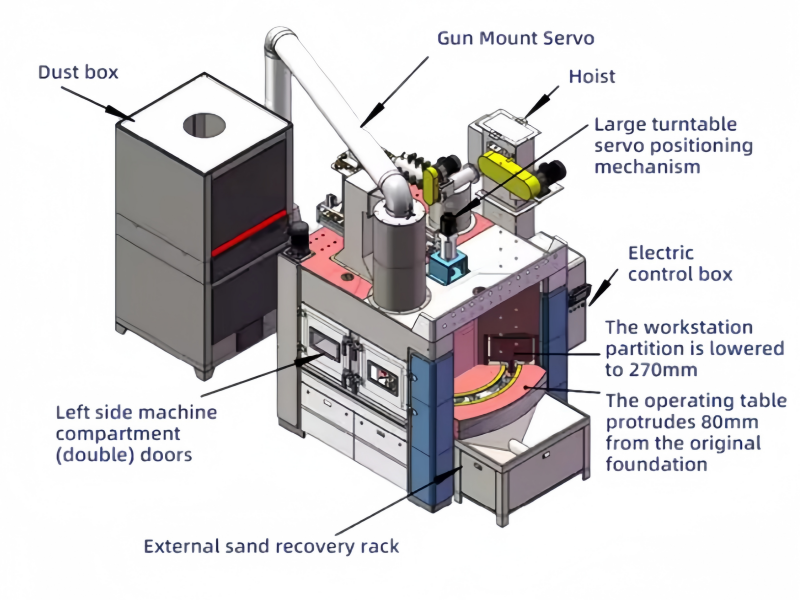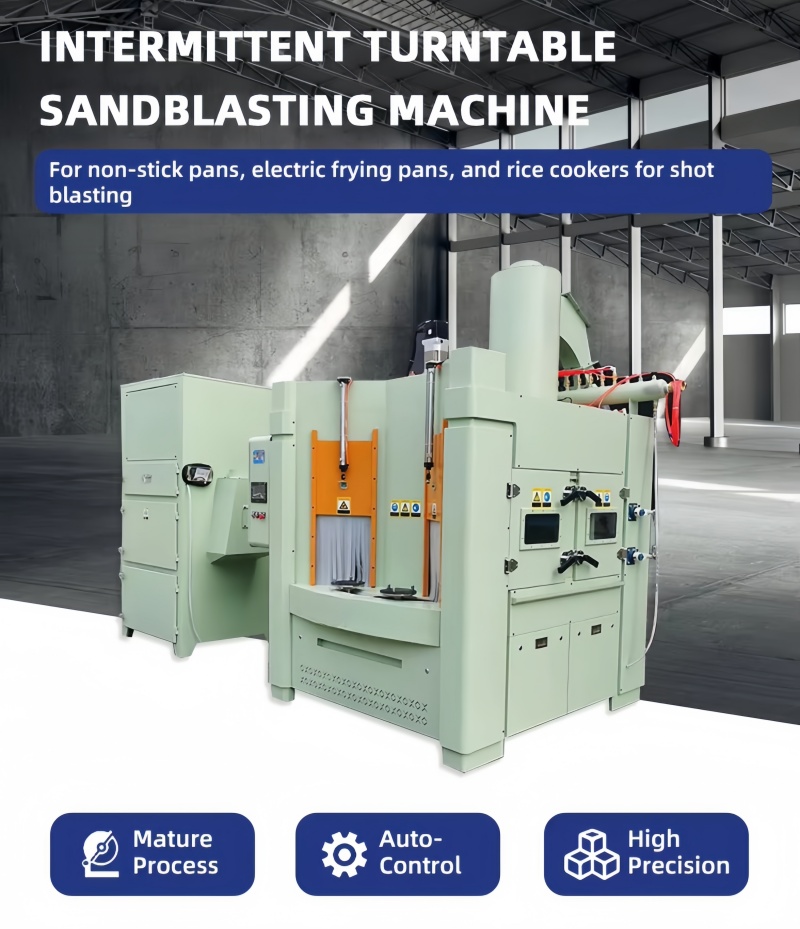Hotline
+86-136 8495 9862
Email:cennia@szmizhi.com
Add::104,Building 27,Third Industrial Zone, Longxi Community,Longgang District,Shenzhen,China.
Coil Forming & Handling Equipment
Surface Treatment Equipment
Solutions
Application
About Us

Welcome to MIZHI
For consultation/feedback, please call the service hotline: +86-136 8495 9862 Email:cennia@szmizhi.com
1.Name:Automatic Sandblaster
2.Model:MZ
3.Operation Way: Automatic
Working Principle
Automatic sandblasting machines are advanced surface treatment devices that use high-pressure air to propel abrasive materials at high speeds onto workpieces to clean and prepare surfaces. The working principle involves several key steps:
1.Compressed Air Generation:
An air compressor generates high-pressure air, which is then regulated to control the pressure and flow. This air is essential for propelling the abrasive material.
2.Abrasive Delivery:
The high-pressure air creates a negative pressure inside the blast gun, drawing abrasive material (such as steel shot, glass beads, or sand) from a storage tank. The abrasive is then propelled through the blast gun.
3.Surface Impact:
The abrasive material is accelerated and ejected from the blast gun, hitting the workpiece surface at high speed. This impact force removes contaminants, rust, paint, and other impurities while increasing surface roughness for better coating adhesion.
4.Material Recovery and Recycling:
After impacting the surface, the abrasive material is collected and separated from waste material. The reusable abrasive is then recycled back into the storage tank for further use.
Detailed Introduction to Automatic Sandblasting Machines
Components of an Automatic Sandblasting System
An automatic sandblasting system typically consists of the following components:
Component | Description |
Compressed Air System | Provides the necessary power for the abrasive delivery. It includes an air compressor, storage tank, filters, and dryers. |
Abrasive Storage and Feeding System | Stores and feeds the abrasive material to the blast gun. This system ensures a steady supply of abrasive material. |
Blast Gun | The core component that directs the high-speed abrasive stream onto the workpiece. It can be fixed or programmable for different spray patterns. |
Workpiece Handling System | Conveys the workpiece through the blasting area, ensuring consistent and uniform treatment. This can include conveyor belts, turntables, or robotic arms. |
Dust Collection and Filtration System | Collects and filters dust and debris generated during the blasting process, protecting the environment and operator health. |
Control System | Manages the entire process, allowing for precise control over parameters such as pressure, distance, and angle. This system ensures consistent results and high efficiency. |
Applications
Automatic sandblasting technology is widely used across various industries for its efficiency and precision. Key applications include:
1.Automotive Industry:
Used for removing paint, rust, and other contaminants from metal parts, ensuring surfaces are clean and smooth before painting or coating. For example, engine blocks and cylinder heads are often sandblasted to remove casting residues and oxidation.
2.Aerospace Industry:
Critical for maintenance, repair, and overhaul (MRO) of components. Automated systems provide precise surface preparation, removing oxides and old coatings without damaging the underlying material. For instance, aircraft engine blades require high-precision sandblasting to ensure optimal performance and safety.
3.Manufacturing Industry:
Employed for cleaning molds, dies, and preparing surfaces for welding or bonding. These systems handle large volumes of workpieces with consistent quality, improving throughput and reducing downtime.
4.Construction and Shipbuilding:
Used to prepare concrete surfaces, clean steel structures, and remove coatings from various materials. In shipbuilding, they maintain hull integrity by removing marine growth and old paint.
5.Glass and Stone Processing:
Used for engraving and decoration. By adjusting the type and particle size of abrasives and the pressure and angle of the spray, unique textures and patterns can be created on glass and stone surfaces.

Advantages
1.High Efficiency:
Automatic sandblasting machines can quickly complete surface treatment, significantly improving production efficiency. For example, a 16-gun automatic sandblasting machine can simultaneously treat large areas, greatly increasing work efficiency.
2.Uniform Surface Quality:
The surface quality of the treated workpieces is uniform and consistent, meeting various high-precision and high-demand production requirements. This ensures that every part is treated to the same high standard.
3.Flexibility:

Automatic sandblasting machines can adjust spray parameters such as pressure, angle, and abrasive type according to different production needs, achieving different surface treatment effects.
4.Labor Savings:
By adopting automation, the need for manual labor is reduced, lowering production costs. This is particularly beneficial in large-scale production environments.
5.Environmental Protection:
Modern automatic sandblasting systems are designed with environmental compliance in mind. They often include dust collection and filtration systems to minimize pollution.
6.Safety:
Reduces worker exposure to hazardous environments, minimizing health risks associated with inhalation of abrasive particles and dust. For example, operators no longer need to wear heavy protective gear, reducing physical strain.
7.Precision Control:
Advanced PLC electrical control systems allow for precise control over the sandblasting process. Parameters such as time, pressure, and abrasive grain size can be adjusted to meet the requirements of different materials and processes.
8.Cost Savings:
While the initial investment can be significant, the long-term savings in labor, improved productivity, and reduced material waste make automated sandblasting a worthwhile investment. For instance, a study showed that automated systems can reduce labor costs by up to 70%.
9.Intelligent and Automated Operation:
With the advancement of industrial 4.0, intelligent and automated operations have become a trend in manufacturing. Automatic sandblasting machines represent this trend, allowing for remote monitoring and operation via touchscreens or computer terminals.
10.Comprehensive Service and Support:
Many manufacturers, such as Dongguan Huachuang Shot Blasting Equipment Co., Ltd., provide not only high-quality equipment but also comprehensive services including installation, debugging, training, and regular maintenance. This ensures the stable operation of the equipment and meets the production needs of customers.
Conclusion
Automatic sandblasting machines are highly efficient and precise surface treatment devices that offer numerous advantages over traditional methods. Their applications span across various industries, from automotive and aerospace to construction and glass processing. The benefits of high efficiency, uniform surface quality, flexibility, labor savings, environmental protection, safety, precision control, cost savings, intelligent operation, and comprehensive service make automatic sandblasting machines an excellent choice for modern manufacturing and processing needs.